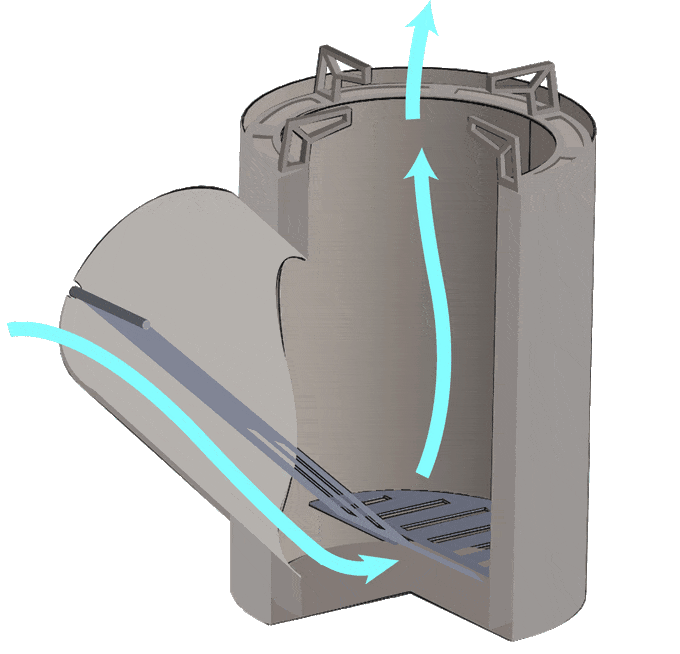Hypocaust
Mass Heater
-
Fuel
Some designs consume 10% of the wood compared to a conventional wood stove to achieve the same room temperature.
-
Heat
Complete combustion of wood under extreme heat, thereby producing higher heat of combustion per unit of wood.
-
Clean Exhaust
When the exhaust gas does eventually leaves the rocket stove mass heater, it mostly consists of just carbon dioxide and steam.

Inspired by Caius Sergius Orata (fl. c. 95 BC)
The public baths at the time were called Thermae because they were built in the year 81 AD in Rome under the rule of Roman Emperor Titus.
Seating representation, after paintings of discoveries in the baths of Titus, vintage engraved illustration. Magasin Pittoresque 1836.
Engineer
Gained recognition for their notable achievements in both oyster cultivation and advancements to the hypocaust method of heating buildings. Notably, their refined approach not only facilitated effective heating within structures but also provided the additional benefit of heated water for bathing purposes.
Brick Lined Heater
Boiler System
Introducing Rocket Stoves
Merely 10% of the solid fuel is required to generate and retain an equivalent amount of heat compared to traditional wood stoves. Remarkably, this system incorporates built-in ventilation mechanisms that operate without the need for electricity, enabling the movement of several cubic feet of air effortlessly and without the use of fans.
Harnessing the Power of Evaporative Filtration: Transforming Deadly Water into Life-Sustaining H2O
In the heart of ancient Rome, where engineering marvels abounded, one innovation in particular stood out as a testament to human ingenuity and comfort: the Hypocaust system. This ingenious method, championed by individuals like Caius Sergius, elevated the art of heating, providing warmth and luxury in an era that predates modern heating systems. In this blog post, we'll embark on a journey to explore the captivating world of Hypocausts, uncover the brilliance of Caius Sergius, and appreciate the enduring legacy of this ancient radiant heating technology.
The Hypocaust system, an integral part of Roman architecture and engineering, was a revolutionary method of indoor heating. It involved a network of underground chambers and channels through which hot air and smoke from a furnace circulated. These chambers were built beneath the floors of grand Roman structures, including bathhouses, villas, and even some public buildings.
While the origins of the Hypocaust system predate recorded history, it's individuals like Caius Sergius who helped perfect and popularize this technology during the Roman Republic and Empire. Caius Sergius, an ingenious engineer and architect of his time, made significant contributions to the development and refinement of the Hypocaust system. His name became synonymous with the art of creating luxurious, heated spaces in the grand edifices of ancient Rome.
The Mechanics of Hypocaust Heating
The functioning of a Hypocaust system was a marvel of engineering. Here's how it worked:
Furnace: A furnace, often located in a separate building or chamber, generated heat by burning wood or other fuels.
Hypocaust Chambers: Hot air and smoke from the furnace were directed through a system of channels and chambers built beneath the floors. These chambers were supported by pillars or stacks of tiles to allow air circulation.
Radiant Heat: The heated air flowed through the spaces below the floors, radiating warmth upward into the rooms above.
Efficient Design: The ingenious design of the Hypocaust system not only provided warmth but also ensured efficient heating without the need for open flames within living spaces.
The Enduring Legacy of Hypocausts
While the Hypocaust system is often associated with the grandeur of ancient Rome, its principles continue to inspire modern radiant heating systems. Today, we can find echoes of this ancient technology in underfloor heating systems that provide comfort and luxury in contemporary homes and buildings.
As we reflect on the radiant warmth of the Hypocaust system and the contributions of visionaries like Caius Sergius, we marvel at the timelessness of innovation. The ancient Romans, with their mastery of engineering, demonstrated that the pursuit of comfort and luxury through technology transcends eras. In a world where heating technology continues to evolve, the Hypocaust system serves as a timeless reminder of our enduring quest for warmth and comfort, bridging the gap between the past and the present.
Food for Thought
Solar Food Dehydrator with Rocket Assist
Solar food dehydrators are an impressive technological solution that proves highly beneficial for food preservation. However, their functionality is limited during nighttime and the colder fall and winter months. To overcome this challenge, an ingenious solution was devised by integrating a rocket heater system into a solar food dehydrator, yielding astounding results. Follow along as Mud explains the inner workings of this remarkable combination.




